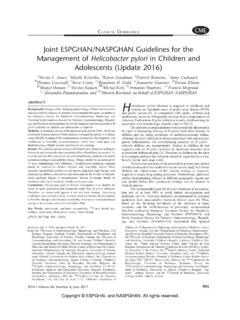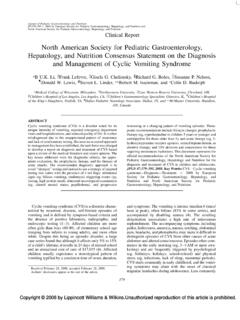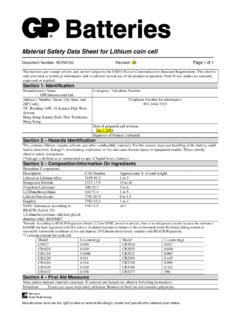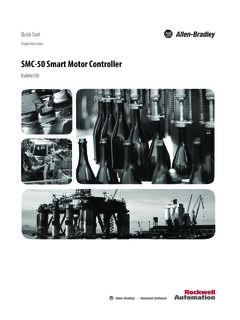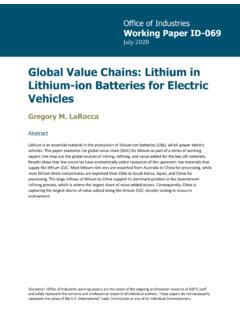Transcription of Management of Ingested Foreign Bodies in ... - NASPGHAN
1 Copyright 2015 by ESPGHAN and NASPGHAN . Unauthorized reproduction of this article is of Ingested Foreign Bodies in Children:A Clinical Report of the NASPGHANE ndoscopy Committee Robert E. Kramer,yDiana G. Lerner,zTom Lin, Michael Manfredi,jjManoj Shah, Thomas C. Stephen,#Troy E. Gibbons, Harpreet Pall,yyBen Sahn,zzMark McOmber, George Zacur, Joel Friedlander,jjjjAntonio J. Quiros, Douglas S. Fishman, and##Petar MamulaABSTRACTF oreign body ingestions in children are some of the most challenging clinicalscenarios facing pediatric gastroenterologists.
2 Determining the indicationsand timing for intervention requires assessment of patient size, type of objectingested, location, clinical symptoms, time since ingestion, and myriad otherfactors. Often the easiest and least anxiety-producing decision is the one toproceed to endoscopic removal, instead of observation alone. Because ofvariability in pediatric patient size, there are less firm guidelines available todetermine which type of object will safely pass, as opposed to the clearerguidelines in the adult population. In addition, the imprecise nature of thehistories often leaves the clinician to question the timing and nature of theingestion.
3 Furthermore, changes in the types of ingestions encountered,specifically button batteries and high-powered magnet ingestions, createan even greater potential for severe morbidity and mortality amongchildren. As a result, clinical guidelines regarding Management of theseingestions in children remain varied and sporadic, with little in the way ofprospective data to guide their development. An expert panel of pediatricendoscopists was convened and produced the present article that outlinespractical clinical approaches to the pediatric patient with a variety offoreign body ingestions.
4 This guideline is intended as an educational toolthat may help inform pediatric endoscopists in managing Foreign bodyingestions in children. Medical decision making, however, remains acomplex process requiring integration of clinical data beyond the scope ofthese guidelines. These guidelines should therefore not be considered tobe a rule or to be establishing a legal standard of care. Caregivers may wellchoose a course of action outside of those represented in these guidelinesbecause of specific patient circumstances. Furthermore, additional clinicalstudies may be necessary to clarify aspects based on expert opinioninstead of published data.
5 Thus, these guidelines may be revised asneeded to account for new data, changes in clinical practice, or avail-ability of new Words:aortoesophageal fistula, button battery, esophageal foodimpaction, Foreign body ingestion, magnet, superabsorbent(JPGN2015;60: 562 574)In 2000 the American Association of Poison Control Centersdocumented that 75% of the>116,000 ingestions reported werein children 5 years of age or younger (1). As opposed to adults, 98%of Foreign body ingestions (FBIs) in children are accidental andinvolve common objects found in the home environment, such ascoins, toys, jewelry, magnets, and batteries (2).
6 Children maypresent with overt symptoms, including, but not limited to, stridor,pain, drooling, fussiness, chest pain, abdominal pain, fever, feedingrefusal, wheezing, and respiratory distress (3). Conversely, they maybe completely asymptomatic but brought in after ingestion witnessedby a caretaker. For the purposes of the present article, FBIs will becategorized into the following major groups: button batteries (BBs),magnets, sharp/pointed objects, food impaction, coins/blunt objects,and superabsorbent objects. Management of caustic agents and othertoxic ingestions is outside the scope of the present an object is in the esophagus, removal is consideredmandatory.
7 The airway should be protected with an endotrachealtube during removal, particularly critical if the patient has beenfasting for<8 hours. Depending on the position of the object andthe nil per os (NPO) status of the patient, removal by anesthesia withMcGill forceps or by ENT with a rigid scope may be alternativesReceived December 29, 2014; accepted January 14, the Department of Pediatrics, University of Colorado, Aurora, theyDepartment of Pediatrics, Medical College of Wisconsin, Milwaukee,thezDepartment of Pediatrics, Cincinnati Children s Hospital MedicalCenter, Cincinnati, OH, the Department of Pediatrics, Harvard MedicalSchool, Boston, MA, thejjDepartment of Pediatrics, Loma LindaUniversity, Loma Linda, CA, the Department of Pediatrics, Universityof Louisville, Louisville, KY, the#Department of Pediatrics, Universityof Arkansas, Fayetteville, the Department of Pediatrics.
8 St Christo-pher s Hospital for Children, Philadelphia, PA, theyyDepartment ofPediatrics, North Shore-Long Island Jewish Medical Center, Great Neck,NY, thezzDepartment of Pediatrics, Phoenix Children s Hospital,Phoenix, AZ, the Department of Pediatrics, University of Michigan,Ann Arbor, thejjjjDepartment of Pediatrics, Medical University of SouthCarolina, Charleston, the Department of Pediatrics, Baylor College ofMedicine, Houston, TX, and the##Department of Pediatrics, Universityof Pennsylvania, correspondence and reprint requests to Robert E.
9 Kramer, MD,13123 E 16th Ave, B290, Aurora, CO 80045 (e-mail: article has been developed as a Journal CME Activity by NASP-GHAN. view instructions, documentation, andthe complete necessary steps to receive CME credit for reading digital content is available for this article. Direct URLcitations appear in the printed text, and links to the digital files areprovided in the HTML text of this article on the journal s Web site( ).Support for meetings of the Endoscopy and Procedures Committee, in whichthe present work was planned, discussed, and revised, was provided bythe North American Society for Pediatric Gastroenterology, Hepatology,and authors report no conflicts of #2015 by European Society for Pediatric Gastroenterology,Hepatology, and Nutrition and North American Society for PediatricGastroenterology, Hepatology, and NutritionDOI: Volume 60, Number 4, April 2015 Copyright 2015 by ESPGHAN and NASPGHAN .)
10 Unauthorized reproduction of this article is endoscopic removal. Timing of endoscopy is dependent on anumber of factors, including clinical status of the patient, the timeof the patient s last oral intake, type of ingestion, and locationwithin the gastrointestinal (GI) tract. Generally speaking, timingcan be divided into categories of emergent (<2 hours frompresentation, regardless of NPO status), urgent (<24 hoursfrom presentation, following usual NPO guidelines), and elective(>24 hours from presentation, following usual NPO guidelines).
